| Listing 1 - 10 of 25 | << page >> |
Sort by
|
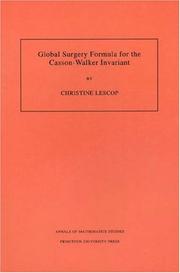
ISBN: 0691021333 1400865158 9781400865154 9780691021331 0691021325 9780691021324 Year: 1996 Volume: 140 Publisher: Princeton, New Jersey : Princeton University Press,
Abstract | Keywords | Export | Availability | Bookmark
 Loading...
Loading...Choose an application
- Reference Manager
- EndNote
- RefWorks (Direct export to RefWorks)
This book presents a new result in 3-dimensional topology. It is well known that any closed oriented 3-manifold can be obtained by surgery on a framed link in S 3. In Global Surgery Formula for the Casson-Walker Invariant, a function F of framed links in S 3 is described, and it is proven that F consistently defines an invariant, lamda (l), of closed oriented 3-manifolds. l is then expressed in terms of previously known invariants of 3-manifolds. For integral homology spheres, l is the invariant introduced by Casson in 1985, which allowed him to solve old and famous questions in 3-dimensional topology. l becomes simpler as the first Betti number increases. As an explicit function of Alexander polynomials and surgery coefficients of framed links, the function F extends in a natural way to framed links in rational homology spheres. It is proven that F describes the variation of l under any surgery starting from a rational homology sphere. Thus F yields a global surgery formula for the Casson invariant.
Chirurgie (Topologie) --- Drie-menigvuldigheden (Topologie) --- Heelkunde (Topologie) --- Surgery (Topology) --- Three-manifolds (Topology) --- Trois-variétés (Topologie) --- 3-manifolds (Topology) --- Manifolds, Three dimensional (Topology) --- Three-dimensional manifolds (Topology) --- Low-dimensional topology --- Topological manifolds --- Differential topology --- Homotopy equivalences --- Manifolds (Mathematics) --- Topology --- 515.16 --- 515.16 Topology of manifolds --- Topology of manifolds --- 3-manifold. --- Addition. --- Alexander polynomial. --- Ambient isotopy. --- Betti number. --- Casson invariant. --- Change of basis. --- Change of variables. --- Cobordism. --- Coefficient. --- Combination. --- Combinatorics. --- Computation. --- Conjugacy class. --- Connected component (graph theory). --- Connected space. --- Connected sum. --- Cup product. --- Determinant. --- Diagram (category theory). --- Disk (mathematics). --- Empty set. --- Exterior (topology). --- Fiber bundle. --- Fibration. --- Function (mathematics). --- Fundamental group. --- Homeomorphism. --- Homology (mathematics). --- Homology sphere. --- Homotopy sphere. --- Indeterminate (variable). --- Integer. --- Klein bottle. --- Knot theory. --- Manifold. --- Morphism. --- Notation. --- Orientability. --- Permutation. --- Polynomial. --- Prime number. --- Projective plane. --- Scientific notation. --- Seifert surface. --- Sequence. --- Summation. --- Symmetrization. --- Taylor series. --- Theorem. --- Topology. --- Tubular neighborhood. --- Unlink.
Book
ISBN: 0691241538 Year: 2023 Publisher: Princeton, New Jersey ; Oxford : Princeton University Press,
Abstract | Keywords | Export | Availability | Bookmark
 Loading...
Loading...Choose an application
- Reference Manager
- EndNote
- RefWorks (Direct export to RefWorks)
The classic book that shares the enjoyment of mathematics with readers of all skill levelsWhat is so special about the number 30? Do the prime numbers go on forever? Are there more whole numbers than even numbers? The Enjoyment of Math explores these and other captivating problems and puzzles, introducing readers to some of the most fundamental ideas in mathematics. Written by two eminent mathematicians and requiring only a background in plane geometry and elementary algebra, this delightful book covers topics such as the theory of sets, the four-color problem, regular polyhedrons, Euler’s proof of the infinitude of prime numbers, and curves of constant breadth. Along the way, it discusses the history behind the problems, carefully explaining how each has arisen and, in some cases, how to resolve it. With an incisive foreword by Alex Kontorovich, this Princeton Science Library edition shares the enjoyment of math with a new generation of readers.
Mathematics --- Mathematical recreations. --- Mathematical puzzles --- Number games --- Recreational mathematics --- Recreations, Mathematical --- Puzzles --- Scientific recreations --- Games in mathematics education --- Magic squares --- Magic tricks in mathematics education --- Arbitrarily large. --- Arithmetic. --- Big O notation. --- Binomial theorem. --- Bonse's inequality. --- Circumference. --- Coefficient. --- Combination. --- Complete theory. --- Computation. --- Coprime integers. --- Diameter. --- Divisor. --- Equilateral triangle. --- Euler's formula. --- Euler's theorem. --- Exterior (topology). --- Factorial. --- Factorization. --- Fermat's Last Theorem. --- Fermat's theorem. --- Fourth power. --- Fractional part. --- Geometric mean. --- Geometric series. --- Geometry. --- Hypotenuse. --- Integer factorization. --- Intersection (set theory). --- Irrational number. --- Line segment. --- Logarithm. --- Long division. --- Mathematical induction. --- Mathematics. --- Metric space. --- Natural number. --- Non-Euclidean geometry. --- Number theory. --- Parallelogram. --- Parity (mathematics). --- Pedal triangle. --- Perfect number. --- Polyhedron. --- Power of 10. --- Prime factor. --- Prime number theorem. --- Prime number. --- Prime power. --- Pure mathematics. --- Pythagorean theorem. --- Rational number. --- Rectangle. --- Regular polygon. --- Regular polyhedron. --- Remainder. --- Reuleaux triangle. --- Rhomboid. --- Rhombus. --- Right angle. --- Right triangle. --- Scientific notation. --- Sign (mathematics). --- Special case. --- Straightedge. --- Summation. --- Theorem. --- Transfinite number. --- Variable (mathematics). --- Waring's problem.
Book

ISBN: 1400882702 Year: 2016 Publisher: Princeton, NJ : Princeton University Press,
Abstract | Keywords | Export | Availability | Bookmark
 Loading...
Loading...Choose an application
- Reference Manager
- EndNote
- RefWorks (Direct export to RefWorks)
These two new collections, numbers 28 and 29 respectively in the Annals of Mathematics Studies, continue the high standard set by the earlier Annals Studies 20 and 24 by bringing together important contributions to the theories of games and of nonlinear differential equations.
Oscillations. --- Addition. --- Analytic function. --- Approximation. --- Arc length. --- Asymptotic expansion. --- Big O notation. --- Bijection. --- Calculation. --- Canonical form. --- Cartesian coordinate system. --- Characteristic equation. --- Characteristic exponent. --- Circumference. --- Clockwise. --- Coefficient matrix. --- Coefficient. --- Concentric. --- Continuous function. --- Contradiction. --- Coordinate system. --- Determinant. --- Differential equation. --- Divisor. --- Dynamical system. --- Equation. --- Existential quantification. --- Exterior (topology). --- First variation. --- Geometry. --- Homotopy. --- Initial condition. --- Integer. --- Intersection (set theory). --- Interval (mathematics). --- Isolated point. --- Iteration. --- Limit cycle. --- Limit set. --- Linear differential equation. --- Linear equation. --- Main diagonal. --- Mathematician. --- Matrix (mathematics). --- Matrix coefficient. --- Monotonic function. --- Natural number. --- Nonlinear system. --- Parameter. --- Partial derivative. --- Periodic function. --- Phase plane. --- Phase portrait. --- Polar coordinate system. --- Polynomial. --- Projective plane. --- Quadratic transformation. --- Requirement. --- Saddle point. --- Separatrix (mathematics). --- Sequence. --- Special case. --- Square matrix. --- Statistical hypothesis testing. --- Structural stability. --- Subset. --- Suggestion. --- Theorem. --- Theory. --- Three-dimensional space (mathematics). --- Time derivative. --- Topology. --- Trigonometric polynomial. --- Uniqueness theorem. --- Unit vector. --- Variable (mathematics). --- Vector field. --- Velocity. --- Without loss of generality.
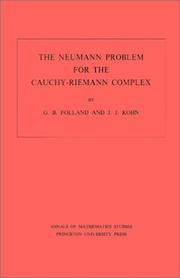
ISBN: 0691081204 1400881528 9780691081205 Year: 1972 Volume: 75 Publisher: Princeton : Princeton University Press,
Abstract | Keywords | Export | Availability | Bookmark
 Loading...
Loading...Choose an application
- Reference Manager
- EndNote
- RefWorks (Direct export to RefWorks)
Part explanation of important recent work, and part introduction to some of the techniques of modern partial differential equations, this monograph is a self-contained exposition of the Neumann problem for the Cauchy-Riemann complex and certain of its applications. The authors prove the main existence and regularity theorems in detail, assuming only a knowledge of the basic theory of differentiable manifolds and operators on Hilbert space. They discuss applications to the theory of several complex variables, examine the associated complex on the boundary, and outline other techniques relevant to these problems. In an appendix they develop the functional analysis of differential operators in terms of Sobolev spaces, to the extent it is required for the monograph.
Functional analysis --- Neumann problem --- Differential operators --- Complex manifolds --- Complex manifolds. --- Differential operators. --- Neumann problem. --- Differential equations, Partial --- Équations aux dérivées partielles --- Analytic spaces --- Manifolds (Mathematics) --- Operators, Differential --- Differential equations --- Operator theory --- Boundary value problems --- A priori estimate. --- Almost complex manifold. --- Analytic function. --- Apply. --- Approximation. --- Bernhard Riemann. --- Boundary value problem. --- Calculation. --- Cauchy–Riemann equations. --- Cohomology. --- Compact space. --- Complex analysis. --- Complex manifold. --- Coordinate system. --- Corollary. --- Derivative. --- Differentiable manifold. --- Differential equation. --- Differential form. --- Differential operator. --- Dimension (vector space). --- Dirichlet boundary condition. --- Eigenvalues and eigenvectors. --- Elliptic operator. --- Equation. --- Estimation. --- Euclidean space. --- Existence theorem. --- Exterior (topology). --- Finite difference. --- Fourier analysis. --- Fourier transform. --- Frobenius theorem (differential topology). --- Functional analysis. --- Hilbert space. --- Hodge theory. --- Holomorphic function. --- Holomorphic vector bundle. --- Irreducible representation. --- Line segment. --- Linear programming. --- Local coordinates. --- Lp space. --- Manifold. --- Monograph. --- Multi-index notation. --- Nonlinear system. --- Operator (physics). --- Overdetermined system. --- Partial differential equation. --- Partition of unity. --- Potential theory. --- Power series. --- Pseudo-differential operator. --- Pseudoconvexity. --- Pseudogroup. --- Pullback. --- Regularity theorem. --- Remainder. --- Scientific notation. --- Several complex variables. --- Sheaf (mathematics). --- Smoothness. --- Sobolev space. --- Special case. --- Statistical significance. --- Sturm–Liouville theory. --- Submanifold. --- Tangent bundle. --- Theorem. --- Uniform norm. --- Vector field. --- Weight function. --- Operators in hilbert space

ISBN: 069108081X 9781400822492 1400822491 9780691080819 Year: 1971 Volume: 66 Publisher: Princeton, N.J.
Abstract | Keywords | Export | Availability | Bookmark
 Loading...
Loading...Choose an application
- Reference Manager
- EndNote
- RefWorks (Direct export to RefWorks)
Intended for researchers in Riemann surfaces, this volume summarizes a significant portion of the work done in the field during the years 1966 to 1971.
Riemann surfaces --- Mathematics --- Physical Sciences & Mathematics --- Calculus --- Surfaces, Riemann --- Functions --- Congresses --- Differential geometry. Global analysis --- RIEMANN SURFACES --- congresses --- Congresses. --- MATHEMATICS / Calculus. --- Affine space. --- Algebraic function field. --- Algebraic structure. --- Analytic continuation. --- Analytic function. --- Analytic set. --- Automorphic form. --- Automorphic function. --- Automorphism. --- Beltrami equation. --- Bernhard Riemann. --- Boundary (topology). --- Canonical basis. --- Cartesian product. --- Clifford's theorem. --- Cohomology. --- Commutative diagram. --- Commutative property. --- Complex multiplication. --- Conformal geometry. --- Conformal map. --- Coset. --- Degeneracy (mathematics). --- Diagram (category theory). --- Differential geometry of surfaces. --- Dimension (vector space). --- Dirichlet boundary condition. --- Eigenfunction. --- Eigenvalues and eigenvectors. --- Eisenstein series. --- Euclidean space. --- Existential quantification. --- Explicit formulae (L-function). --- Exterior (topology). --- Finsler manifold. --- Fourier series. --- Fuchsian group. --- Function (mathematics). --- Generating set of a group. --- Group (mathematics). --- Hilbert space. --- Holomorphic function. --- Homeomorphism. --- Homology (mathematics). --- Homotopy. --- Hyperbolic geometry. --- Hyperbolic group. --- Identity matrix. --- Infimum and supremum. --- Inner automorphism. --- Intersection (set theory). --- Intersection number (graph theory). --- Isometry. --- Isomorphism class. --- Isomorphism theorem. --- Kleinian group. --- Limit point. --- Limit set. --- Linear map. --- Lorentz group. --- Mapping class group. --- Mathematical induction. --- Mathematics. --- Matrix (mathematics). --- Matrix multiplication. --- Measure (mathematics). --- Meromorphic function. --- Metric space. --- Modular group. --- Möbius transformation. --- Number theory. --- Osgood curve. --- Parity (mathematics). --- Partial isometry. --- Poisson summation formula. --- Pole (complex analysis). --- Projective space. --- Quadratic differential. --- Quadratic form. --- Quasiconformal mapping. --- Quotient space (linear algebra). --- Quotient space (topology). --- Riemann mapping theorem. --- Riemann sphere. --- Riemann surface. --- Riemann zeta function. --- Scalar multiplication. --- Scientific notation. --- Selberg trace formula. --- Series expansion. --- Sign (mathematics). --- Square-integrable function. --- Subgroup. --- Teichmüller space. --- Theorem. --- Topological manifold. --- Topological space. --- Uniformization. --- Unit disk. --- Variable (mathematics). --- Riemann, Surfaces de --- RIEMANN SURFACES - congresses --- Fonctions d'une variable complexe --- Surfaces de riemann
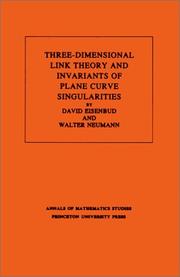
ISBN: 0691083819 0691083800 1400881927 9780691083810 9780691083803 Year: 1985 Volume: 110 Publisher: Princeton Princeton University Press
Abstract | Keywords | Export | Availability | Bookmark
 Loading...
Loading...Choose an application
- Reference Manager
- EndNote
- RefWorks (Direct export to RefWorks)
This book gives a new foundation for the theory of links in 3-space modeled on the modern developmentby Jaco, Shalen, Johannson, Thurston et al. of the theory of 3-manifolds. The basic construction is a method of obtaining any link by "splicing" links of the simplest kinds, namely those whose exteriors are Seifert fibered or hyperbolic. This approach to link theory is particularly attractive since most invariants of links are additive under splicing.Specially distinguished from this viewpoint is the class of links, none of whose splice components is hyperbolic. It includes all links constructed by cabling and connected sums, in particular all links of singularities of complex plane curves. One of the main contributions of this monograph is the calculation of invariants of these classes of links, such as the Alexander polynomials, monodromy, and Seifert forms.
Algebraic geometry --- Differential geometry. Global analysis --- Link theory. --- Curves, Plane. --- SINGULARITIES (Mathematics) --- Curves, Plane --- Invariants --- Link theory --- Singularities (Mathematics) --- Geometry, Algebraic --- Low-dimensional topology --- Piecewise linear topology --- Higher plane curves --- Plane curves --- Invariants. --- 3-sphere. --- Alexander Grothendieck. --- Alexander polynomial. --- Algebraic curve. --- Algebraic equation. --- Algebraic geometry. --- Algebraic surface. --- Algorithm. --- Ambient space. --- Analytic function. --- Approximation. --- Big O notation. --- Call graph. --- Cartesian coordinate system. --- Characteristic polynomial. --- Closed-form expression. --- Cohomology. --- Computation. --- Conjecture. --- Connected sum. --- Contradiction. --- Coprime integers. --- Corollary. --- Curve. --- Cyclic group. --- Determinant. --- Diagram (category theory). --- Diffeomorphism. --- Dimension. --- Disjoint union. --- Eigenvalues and eigenvectors. --- Equation. --- Equivalence class. --- Euler number. --- Existential quantification. --- Exterior (topology). --- Fiber bundle. --- Fibration. --- Foliation. --- Fundamental group. --- Geometry. --- Graph (discrete mathematics). --- Ground field. --- Homeomorphism. --- Homology sphere. --- Identity matrix. --- Integer matrix. --- Intersection form (4-manifold). --- Isolated point. --- Isolated singularity. --- Jordan normal form. --- Knot theory. --- Mathematical induction. --- Monodromy matrix. --- Monodromy. --- N-sphere. --- Natural transformation. --- Newton polygon. --- Newton's method. --- Normal (geometry). --- Notation. --- Pairwise. --- Parametrization. --- Plane curve. --- Polynomial. --- Power series. --- Projective plane. --- Puiseux series. --- Quantity. --- Rational function. --- Resolution of singularities. --- Riemann sphere. --- Riemann surface. --- Root of unity. --- Scientific notation. --- Seifert surface. --- Set (mathematics). --- Sign (mathematics). --- Solid torus. --- Special case. --- Stereographic projection. --- Submanifold. --- Summation. --- Theorem. --- Three-dimensional space (mathematics). --- Topology. --- Torus knot. --- Torus. --- Tubular neighborhood. --- Unit circle. --- Unit vector. --- Unknot. --- Variable (mathematics).
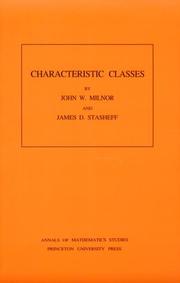
ISBN: 0691081220 9780691081229 140088182X Year: 2016 Volume: 76 Publisher: Princeton, NJ : Princeton University Press,
Abstract | Keywords | Export | Availability | Bookmark
 Loading...
Loading...Choose an application
- Reference Manager
- EndNote
- RefWorks (Direct export to RefWorks)
The theory of characteristic classes provides a meeting ground for the various disciplines of differential topology, differential and algebraic geometry, cohomology, and fiber bundle theory. As such, it is a fundamental and an essential tool in the study of differentiable manifolds.In this volume, the authors provide a thorough introduction to characteristic classes, with detailed studies of Stiefel-Whitney classes, Chern classes, Pontrjagin classes, and the Euler class. Three appendices cover the basics of cohomology theory and the differential forms approach to characteristic classes, and provide an account of Bernoulli numbers.Based on lecture notes of John Milnor, which first appeared at Princeton University in 1957 and have been widely studied by graduate students of topology ever since, this published version has been completely revised and corrected.
Algebraic topology --- Characteristic classes --- Classes caractéristiques --- 515.16 --- #WWIS:d.d. Prof. L. Bouckaert/ALTO --- Classes, Characteristic --- Differential topology --- Topology of manifolds --- Characteristic classes. --- 515.16 Topology of manifolds --- Classes caractéristiques --- Additive group. --- Axiom. --- Basis (linear algebra). --- Boundary (topology). --- Bundle map. --- CW complex. --- Canonical map. --- Cap product. --- Cartesian product. --- Characteristic class. --- Charles Ehresmann. --- Chern class. --- Classifying space. --- Coefficient. --- Cohomology ring. --- Cohomology. --- Compact space. --- Complex dimension. --- Complex manifold. --- Complex vector bundle. --- Complexification. --- Computation. --- Conformal geometry. --- Continuous function. --- Coordinate space. --- Cross product. --- De Rham cohomology. --- Diffeomorphism. --- Differentiable manifold. --- Differential form. --- Differential operator. --- Dimension (vector space). --- Dimension. --- Direct sum. --- Directional derivative. --- Eilenberg–Steenrod axioms. --- Embedding. --- Equivalence class. --- Euler class. --- Euler number. --- Existence theorem. --- Existential quantification. --- Exterior (topology). --- Fiber bundle. --- Fundamental class. --- Fundamental group. --- General linear group. --- Grassmannian. --- Gysin sequence. --- Hausdorff space. --- Homeomorphism. --- Homology (mathematics). --- Homotopy. --- Identity element. --- Integer. --- Interior (topology). --- Isomorphism class. --- J-homomorphism. --- K-theory. --- Leibniz integral rule. --- Levi-Civita connection. --- Limit of a sequence. --- Linear map. --- Metric space. --- Natural number. --- Natural topology. --- Neighbourhood (mathematics). --- Normal bundle. --- Open set. --- Orthogonal complement. --- Orthogonal group. --- Orthonormal basis. --- Partition of unity. --- Permutation. --- Polynomial. --- Power series. --- Principal ideal domain. --- Projection (mathematics). --- Representation ring. --- Riemannian manifold. --- Sequence. --- Singular homology. --- Smoothness. --- Special case. --- Steenrod algebra. --- Stiefel–Whitney class. --- Subgroup. --- Subset. --- Symmetric function. --- Tangent bundle. --- Tensor product. --- Theorem. --- Thom space. --- Topological space. --- Topology. --- Unit disk. --- Unit vector. --- Variable (mathematics). --- Vector bundle. --- Vector space. --- Topologie differentielle --- Classes caracteristiques --- Classes et nombres caracteristiques

ISBN: 0691082847 0691082790 1400881447 9780691082844 Year: 2016 Volume: 99 Publisher: Princeton, NJ : Princeton University Press,
Abstract | Keywords | Export | Availability | Bookmark
 Loading...
Loading...Choose an application
- Reference Manager
- EndNote
- RefWorks (Direct export to RefWorks)
The theory of Toeplitz operators has come to resemble more and more in recent years the classical theory of pseudodifferential operators. For instance, Toeplitz operators possess a symbolic calculus analogous to the usual symbolic calculus, and by symbolic means one can construct parametrices for Toeplitz operators and create new Toeplitz operators out of old ones by functional operations.If P is a self-adjoint pseudodifferential operator on a compact manifold with an elliptic symbol that is of order greater than zero, then it has a discrete spectrum. Also, it is well known that the asymptotic behavior of its eigenvalues is closely related to the behavior of the bicharacteristic flow generated by its symbol.It is natural to ask if similar results are true for Toeplitz operators. In the course of answering this question, the authors explore in depth the analogies between Toeplitz operators and pseudodifferential operators and show that both can be viewed as the "quantized" objects associated with functions on compact contact manifolds.
Operator theory --- Toeplitz operators --- Spectral theory (Mathematics) --- 517.984 --- Spectral theory of linear operators --- Toeplitz operators. --- Spectral theory (Mathematics). --- 517.984 Spectral theory of linear operators --- Operators, Toeplitz --- Linear operators --- Functional analysis --- Hilbert space --- Measure theory --- Transformations (Mathematics) --- Algebraic variety. --- Asymptotic analysis. --- Asymptotic expansion. --- Big O notation. --- Boundary value problem. --- Change of variables. --- Chern class. --- Codimension. --- Cohomology. --- Compact group. --- Complex manifold. --- Complex vector bundle. --- Connection form. --- Contact geometry. --- Corollary. --- Cotangent bundle. --- Curvature form. --- Diffeomorphism. --- Differentiable manifold. --- Dimensional analysis. --- Discrete spectrum. --- Eigenvalues and eigenvectors. --- Elaboration. --- Elliptic operator. --- Embedding. --- Equivalence class. --- Existential quantification. --- Exterior (topology). --- Fourier integral operator. --- Fourier transform. --- Hamiltonian vector field. --- Holomorphic function. --- Homogeneous function. --- Hypoelliptic operator. --- Integer. --- Integral curve. --- Integral transform. --- Invariant subspace. --- Lagrangian (field theory). --- Lagrangian. --- Limit point. --- Line bundle. --- Linear map. --- Mathematics. --- Metaplectic group. --- Natural number. --- Normal space. --- One-form. --- Open set. --- Operator (physics). --- Oscillatory integral. --- Parallel transport. --- Parameter. --- Parametrix. --- Periodic function. --- Polynomial. --- Projection (linear algebra). --- Projective variety. --- Pseudo-differential operator. --- Q.E.D. --- Quadratic form. --- Quantity. --- Quotient ring. --- Real number. --- Scientific notation. --- Self-adjoint. --- Smoothness. --- Spectral theorem. --- Spectral theory. --- Square root. --- Submanifold. --- Summation. --- Support (mathematics). --- Symplectic geometry. --- Symplectic group. --- Symplectic manifold. --- Symplectic vector space. --- Tangent space. --- Theorem. --- Todd class. --- Toeplitz algebra. --- Toeplitz matrix. --- Toeplitz operator. --- Trace formula. --- Transversal (geometry). --- Trigonometric functions. --- Variable (mathematics). --- Vector bundle. --- Vector field. --- Vector space. --- Volume form. --- Wave front set. --- Opérateurs pseudo-différentiels
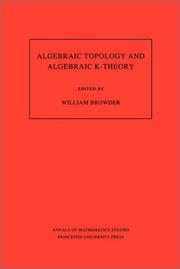
ISBN: 0691084157 0691084262 1400882117 Year: 1987 Publisher: Princeton (N.J.): Princeton university press
Abstract | Keywords | Export | Availability | Bookmark
 Loading...
Loading...Choose an application
- Reference Manager
- EndNote
- RefWorks (Direct export to RefWorks)
This book contains accounts of talks held at a symposium in honorof John C. Moore in October 1983 at Princeton University, The workincludes papers in classical homotopy theory, homological algebra,rational homotopy theory, algebraic K-theory of spaces, and othersubjects.
Algebraic topology --- K-theory --- 512.73 --- 515.14 --- 512.73 Cohomology theory of algebraic varieties and schemes --- Cohomology theory of algebraic varieties and schemes --- 515.14 Algebraic topology --- Moore, John C. --- Abelian group. --- Adams spectral sequence. --- Adjoint functors. --- Adjunction (field theory). --- Algebraic K-theory. --- Algebraic closure. --- Algebraic geometry. --- Algebraic group. --- Algebraic number field. --- Algebraic space. --- Algebraic topology. --- Algebraically closed field. --- Associative algebra. --- Boundary (topology). --- CW complex. --- Classification theorem. --- Closure (mathematics). --- Coalgebra. --- Cofibration. --- Cohomology. --- Commutative diagram. --- Commutative property. --- Coproduct. --- Deformation theory. --- Degenerate bilinear form. --- Diagram (category theory). --- Differentiable manifold. --- Dimension (vector space). --- Division algebra. --- Eilenberg–Moore spectral sequence. --- Epimorphism. --- Exterior (topology). --- Formal power series. --- Free Lie algebra. --- Free algebra. --- Freudenthal suspension theorem. --- Function (mathematics). --- Function space. --- Functor. --- G-module. --- Galois extension. --- Global dimension. --- Group cohomology. --- Group homomorphism. --- H-space. --- Hilbert's Theorem 90. --- Homology (mathematics). --- Homomorphism. --- Homotopy category. --- Homotopy group. --- Homotopy. --- Hopf algebra. --- Hopf invariant. --- Hurewicz theorem. --- Inclusion map. --- Inequality (mathematics). --- Integral domain. --- Isometry. --- Isomorphism class. --- K-theory. --- Lie algebra. --- Lie group. --- Limit (category theory). --- Loop space. --- Mathematician. --- Mathematics. --- Noetherian ring. --- Order topology. --- P-adic number. --- Polynomial ring. --- Polynomial. --- Prime number. --- Principal bundle. --- Principal ideal domain. --- Projective module. --- Projective plane. --- Pullback (category theory). --- Pushout (category theory). --- Ring of integers. --- Series (mathematics). --- Sheaf (mathematics). --- Simplicial category. --- Simplicial complex. --- Simplicial set. --- Special case. --- Spectral sequence. --- Square (algebra). --- Stable homotopy theory. --- Steenrod algebra. --- Superalgebra. --- Theorem. --- Topological K-theory. --- Topological space. --- Topology. --- Triviality (mathematics). --- Uniqueness theorem. --- Universal enveloping algebra. --- Vector bundle. --- Weak equivalence (homotopy theory). --- William Browder (mathematician). --- Géométrie algébrique --- K-théorie
Book
ISBN: 0691081093 9781400871261 1400871263 9780691620114 9780691081090 0691620113 9780691081090 0691646945 Year: 2015 Volume: 11 Publisher: Princeton, NJ : Princeton University Press,
Abstract | Keywords | Export | Availability | Bookmark
 Loading...
Loading...Choose an application
- Reference Manager
- EndNote
- RefWorks (Direct export to RefWorks)
This book has as its subject the boundary value theory of holomorphic functions in several complex variables, a topic that is just now coming to the forefront of mathematical analysis. For one variable, the topic is classical and rather well understood. In several variables, the necessary understanding of holomorphic functions via partial differential equations has a recent origin, and Professor Stein's book, which emphasizes the potential-theoretic aspects of the boundary value problem, should become the standard work in the field.Originally published in 1972.The Princeton Legacy Library uses the latest print-on-demand technology to again make available previously out-of-print books from the distinguished backlist of Princeton University Press. These editions preserve the original texts of these important books while presenting them in durable paperback and hardcover editions. The goal of the Princeton Legacy Library is to vastly increase access to the rich scholarly heritage found in the thousands of books published by Princeton University Press since its founding in 1905.
Mathematical potential theory --- Holomorphic functions --- Harmonic functions --- Holomorphic functions. --- Harmonic functions. --- Fonctions de plusieurs variables complexes. --- Functions of several complex variables --- Functions, Harmonic --- Laplace's equations --- Bessel functions --- Differential equations, Partial --- Fourier series --- Harmonic analysis --- Lamé's functions --- Spherical harmonics --- Toroidal harmonics --- Functions, Holomorphic --- Absolute continuity. --- Absolute value. --- Addition. --- Ambient space. --- Analytic function. --- Arbitrarily large. --- Bergman metric. --- Borel measure. --- Boundary (topology). --- Boundary value problem. --- Bounded set (topological vector space). --- Boundedness. --- Brownian motion. --- Calculation. --- Change of variables. --- Characteristic function (probability theory). --- Combination. --- Compact space. --- Complex analysis. --- Complex conjugate. --- Computation. --- Conformal map. --- Constant term. --- Continuous function. --- Coordinate system. --- Corollary. --- Cramer's rule. --- Determinant. --- Diameter. --- Dimension. --- Elliptic operator. --- Estimation. --- Existential quantification. --- Explicit formulae (L-function). --- Exterior (topology). --- Fatou's theorem. --- Function space. --- Green's function. --- Green's theorem. --- Haar measure. --- Half-space (geometry). --- Harmonic function. --- Hilbert space. --- Holomorphic function. --- Hyperbolic space. --- Hypersurface. --- Hölder's inequality. --- Invariant measure. --- Invertible matrix. --- Jacobian matrix and determinant. --- Line segment. --- Linear map. --- Lipschitz continuity. --- Local coordinates. --- Logarithm. --- Majorization. --- Matrix (mathematics). --- Maximal function. --- Measure (mathematics). --- Minimum distance. --- Natural number. --- Normal (geometry). --- Open set. --- Order of magnitude. --- Orthogonal complement. --- Orthonormal basis. --- Parameter. --- Poisson kernel. --- Positive-definite matrix. --- Potential theory. --- Projection (linear algebra). --- Quadratic form. --- Quantity. --- Real structure. --- Requirement. --- Scientific notation. --- Sesquilinear form. --- Several complex variables. --- Sign (mathematics). --- Smoothness. --- Subgroup. --- Subharmonic function. --- Subsequence. --- Subset. --- Summation. --- Tangent space. --- Theorem. --- Theory. --- Total variation. --- Transitive relation. --- Transitivity. --- Transpose. --- Two-form. --- Unit sphere. --- Unitary matrix. --- Vector field. --- Vector space. --- Volume element. --- Weak topology.
| Listing 1 - 10 of 25 | << page >> |
Sort by
|

 Search
Search Feedback
Feedback About
About Help
Help News
News